 |
| Phalaris (GB) |
 |
| Phalaris (GB) |
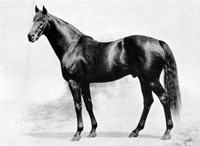 Photograph by W A Rouch © Thoroughbred  Edward George Villiers Stanley (1865-1948), 17th Earl of Derby, was esteemed for service rendered to his country as well as that rendered to the turf. He is regarded as one of the great breeders of the 20th century, although he could scarcely have imagined that by the 21st century most racehorses in the world would descend from Phalaris. Sire  Polymelus, by Cyllene Phalaris Pharos (1920) . Nearco (1935) Manna (1922) . Colombo (1931) Colorado (1923) Sickle (1924) . Unbreakable (1935) . Polynesian (1942) . Native Dancer (1950) Fairway (1925) . Fair Trial (1932) . Blue Peter (1936) Pharamond (1925) Menow (1935) Tom Fool (1949) |
Phalaris br c 1913 (Polymelus
- Bromus, by Sainfoin). Sire Line Phalaris.
Family 1-i. Phalaris was bred by the 17th Earl of Derby, a sportsman of great repute. He bred and raced many winners, including 20 classics winners, such as the Derby winners Hyperion (ch c 1930 Gainsborough) and Sansovino (b c 1921 Swynford) and the St Leger winners Swynford (br c 1907 John O'Gaunt) and Fairway (br c 1925 Phalaris). Bromus (b f 1905 Sainfoin), the dam of Phalaris, was purchased for 3200 guineas by Lord Derby from a sale at Newmarket occasioned by the death of her owner, Mr Houldsworth. Phalaris was a half brother to Mille Fleurs (br f 1910 Andover), the dam of the Hardwicke Stakes winner Sir Douglas (b c 1916 Stedfast), and a half brother to Hainault (br c 1914 Swynford), a useful stallion, who got, among others, the Irish Derby winner Haine (b c 1921), the Irish Oaks winners Amethystine (br f 1921) and Haintonette (ch f 1925), Sweet Hainault (b f 1921) the dam of the Cambridgeshire winner Wychwood Abbot (b c 1931 The Black Abbot), and Baton (br f 1921) who established a successful family in America. |
|||||||||||||||||||||||||||||||||||||||||
|
|
||||||||||||||||||||||||||||||||||||||||||
|
||||||||||||||||||||||||||||||||||||||||||
|
|
||||||||||||||||||||||||||||||||||||||||||
| Phalaris ran 24 times over 4 years, mostly at
Newmarket due to the conditions imposed by World War I. He won 16 of these
races, including
2 walkovers, earning £5,475. He was unplaced for the 2000 Guineas, won
by Clarissimus (ch c 1913 Radium), and did not start for
the Derby or St Leger. He won from 5 to 10 furlongs (1m 2f), and in his
day was regarded as a middle distance runner. The New York trainer Holly Hughes, who had won the Kentucky Derby for the Sanford family with George Smith (bl c 1913 Out of Reach) attempted to purchase Phalaris but was sold Archaic (ch c 1917 Polymelus) instead. Archaic, son of an Oaks winner, had won the Prince of Wales's Stakes and run second for the Derby. Phalaris entered Lord Derby's stud, where he may have gotten better mates than he would have elsewhere. He was thought to cross well with mares by Chaucer (bred by the 16th Earl). His best runners were Fairway (£42,722), Colorado(£30,359), Manna (£23,534) and Pharos (£15,694). However, his presence in the new world owed much to Sickle and Pharamond. Phalaris was Champion Sire in 1925 and 1928, and Champion Broodmare Sire in 1937, 1941 and 1942. He died February 28, 1931 immediately after covering the mare Princess Sublime at Lord Derby's Newmarket stud. |
||||||||||||||||||||||||||||||||||||||||||
|
|
||||||||||||||||||||||||||||||||||||||||||
| Race Record | ||||||||||||||||||||||||||||||||||||||||||
| In 1915 Ran unplaced and unnamed for the £10 each First Spring Two Year Old Stakes over 5 furlongs at Newmarket, won by Lady James Douglas's Foxgrove (ch c 1913 St Amant). Won the £10 each Stud Produce Stakes over 5 furlongs at Newmarket by a head, beating Lord Harewood's Condottiere (b c 1913 Sir Archibald), P P Gilpin's Jack Tar (ch c 1913 Rodney) and 8 others. Won the £300 Redmere Nursery Plate over 5 furlongs at Newmarket in a canter, beating Lord Savil's Llangwm colt, Lady de Bathe's Verge (br c 1915 Aquascutum) and 17 others. In 1916 Finished 3° for the £10 each Newmarket Craven Stakes over 8 furlongs, won in a tie by His Majesty's Sir Dighton (b c 1913 Bayardo) and Major D McCalmont's Roi d'Ecosse (ch c 1913 Roi Herode). Unplaced for the £100 each Two Thousand Guineas Stakes over 8 furlongs at Newmarket, won by Lord Falmouth's Clarissimus (ch c 1913 Radium), with Mr Fairie's Kwang-Su (b c 1913 Cicero) finishing 2°, and Mr J Sanford's Nassovian (b c 1913 William the Third) 3°; 17 started. Unplaced for the £10 each Stewards' Handicap over 6 furlongs at Newmarket, won by Lord Savile's All Serene (b c 1913 Llangwm), with Mr E Hulton's Torloisk (ch c 1912 Gallinule) finishing 2°, and Mr F Potter's Calder Vale (b g 1912 Captivation) 3°. Won the £10 each Beaufort Stakes over 7 furlongs at Newmarket easily, beating Mr E Hulton's Pennant (bl g 1912 Earla Mor) the Duke of Westminster's Manxman (b c 1912 Troutbeck) and Mrs Keith Arbuthnot's Sweetest Melody (b f 1911 Sir Edgar). Won the £1000 St George's Handicap over 6 furlongs at Windsor by 6 lengths, beating Mr L Neumann's Middle Park Stakes winner Argos (b c 1913 Sundridge), the July Cup winner Torloisk and 8 others. Won the £100 each Royal Post Stakes over 10 furlongs at Newmarket, beating Major W Astor's Plymouth (b g 1913 Spearmint) and the Duke of Portland's St Loe (b c 1913 Primer). Finished 2° for the £20 each Limekiln Stakes over 10 furlongs at Newmarket Houghton, won by Mr G D Smith's Bosket (b c 1913 Amadis), with Mr W M G Singer's Market Girl (b f 1913 Martagon) finishing 3°. In 1917 Finished 2° for the £300 Crawfurd Plate (Class 1) over 6 furlongs at Newmarket Craven, won by Mr O W Rayner's Verdun (b c 1913 Feather Bed) to whom he conceded 22 pounds, beating 9 others. Won the £400 Bretby Handicap over 6 furlongs at Newmarket First Spring, beating 13 others, among them Colonel Hall Walker's Forest Guard (ch c 1913 White Eagle), carrying more weight than any of them. Walked over (2 miles and 118 yards) for The Whip at Newmarket. Won the £5 each Chesterfield Course Stakes over 5 furlongs at Newmarket, beating Forest Guard and 2 others. Won the 5 furlong £500 St Ives Handicap over 5 furlongs at Newmarket, conceding 15 to 47 pounds to his 15 rivals. Won the £300 Bury St Edmunds Plate over a mile, beating Mr G D Smith's Bosket (bbr c 1913 Amadis) and Mr E Hulton's Derby and Oaks winner Fifinella (ch f 1913 Polymelus). Won the £5 each Snailwell Stakes over 5 furlongs at Newmarket First October, beating Forest Guard and 4 others. Won the £20 each Challenge Stakes over 6 furlongs at Newmarket Second October with ease, beating 2 others. Finished 4° for the Cambridgeshire Stakes over 1 mile and 1 furlong at Newmarket Houghton, won by Sir A Bailey's Brown Prince (br c 1914 Dark Ronald). In 1918 Won the £200 Abingdon Plate over 5 furlongs at Newmarket Second Spring, beating Mr Sol Joel's Syndrian (b c 1915 Sunder), Mr R B Hopkin's Lady Sylvia (b f 1915 Prince Palatine) and 5 others, winning by half a length and carrying over a stone more than his nearest rival. Went unplaced for the £500 Beaufort Handicap over 5 furlongs at Manchester, won by Mr Joel's Syndrian and Mr C Hailey's Cimarron (b c 1913 Symington). Won the £20 each June Stakes over the Bunbury Mile at Newmarket, beating Mr L Winan's Planet (b c 1914 St Frusquin), M M Calmann's Bapaume (b c 1914 Bayardo), Mr Fraser's Brown Prince and 1 other. Won the £200 Lanwades Plate over 7 furlongs, beating the Duke of Portland's Device (b f 1915 Amadis) by a length, and 7 others. Walked over for the Challenge Stakes. |
||||||||||||||||||||||||||||||||||||||||||
|
|
||||||||||||||||||||||||||||||||||||||||||
| Why Phalaris? It's estimated that 90-95% of the current global Thoroughbred population traces in pedigree topline to Eclipse (1764), the modern patrilineal conduit of the Darley Arabian in the Thoroughbred. A substantial majority of those tracing to Eclipse do so through Phalaris whose 'market share' continues to increase steadily, over a century after he was foaled. Countless quantities of paper, ink, and bandwidth have been devoted to these facts, all too often in the process of constructing myths heavily dependent on the assumption that Phalaris' dominance in pedigree top lines is due to genetic factors exclusive to a 'sire line'. The only such factor is the non-recombinant, male specific portion of the equine Y chromosome (MSY), the smallest chromosome in the nuclear genome. MSY diversity was dramatically reduced during the domestication process. Most horses of western European breeds, including the Thoroughbred, are close MSY 'relatives'. By stud book record, three foundation era sires are still active in patrilineal descent in the Thoroughbred, the Darley Arabian, Byerley Turk and Godolphin Arabian. Their MSY types differ very little. Many sires whose patrilineal descendancies withered as Phalaris' flourished had the same MSY type that he did. The genetic factors involved in establishing and sustaining his sire line dominance cannot be explained in terms of MSY. Perhaps the simplest and most plausible explanation for Phalaris' long term 'sire line' success is that it had to be someone. Within the artificial breeding environment of the Thoroughbred far fewer males are required than females. Tail male descendancies inevitably contract, especially since the advent of larger books and stallion shuttling. Sooner or later, most contract into extinction; in the Thoroughbred about 40 historic sire lines have already vanished for want of a sire successful enough in the stud that demand for his sons and grandsons re-expanded his line. Phalaris simply represents a re-expansion in the Darley Arabian tail male descendancy. A nod to Chaucer for his assistance is certainly in order. Phalaris' most successful sons, on the track as well as in the stud, were out of Chaucer mares. One of those sons, Pharos, got the extraordinarily successful Nearco through whose sons Nasrullah and Royal Charger and, especially, his grandson Northern Dancer, a majority of the most successful stallions of the last four decades in the major TB breeding centers around the globe trace to Phalaris. The number of major sustained expansions at and soon (generationally) after Nearco is highly unusual, if not unprecedented. Ironically, perhaps, this would never have happened had Sibola (1896 USA, 3d dam of Nearco) and Americus (1891 USA, 5th damsire of Nasrullah, 6th damsire of Royal Charger) not been accepted into the General Stud Book before the Jersey Act took effect in the year Phalaris was foaled (1913). Otherwise, Nearco would probably never have stood in Great Britain where he and his progeny would have been considered Half-Breds. Ditto grandson Northern Dancer, through whose dam even more questionable lines were introduced, but he was foaled in Canada (governed by a different registry) over a decade after the Act was, wisely, modified. In 1970, 35 years after Nearco's birth, a bay colt was foaled in Kentucky who would open a second significant expansion of Phalaris' tail male descendancy, this one tracing through son Sickle. The brilliant stakes-winning sprinter Mr. Prospector debuted at stud in 1975 in Florida. then moved to Kentucky, eventually becoming the most successful North American dirt-racing sire, ever. It is too early to determine whether this expansion will rival or displace Nearco's global dominance but the potential exists. Mr. Prospector lived to the age of 29, getting 25 foal crops, the last in 2000. He still has a few sons, not to mention many grandsons, great-grandsons &c., active in the studs of most major TB breeding centers. Except for major expansions at Nearco and Mr. Prospector, Phalaris' tail male descendancy is only slightly less contracted than that of other successful sires of his era. It is reasonable to think that Phalaris himself, via recombinant nuclear DNA, contributed in some signficant genetic measure to a grandson's (Nearco) successes. Where Mr. Prospector is concerned, 6 generations removed from Phalaris via his sire and damsire, that's less likely. Reports from and presentations by the research community hint that Mr. Prospector and Nearco may have been conduits of novel or rare variants in recombinant nuclear DNA that have attracted strong positive selection. It seems quite possible that the extraordinary success of their tail male descendancies has little or nothing to do with Phalaris. His long-term dominance in sire line may be pure serendipity. J Baugh |
||||||||||||||||||||||||||||||||||||||||||
|
|
||||||||||||||||||||||||||||||||||||||||||
| Pharos (GB) | ||||||||||||||||||||||||||||||||||||||||||
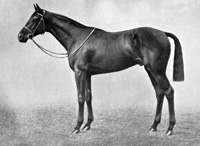 Photograph by W W Rouch © Thoroughbred  Nearco |
Pharos bbr c 1920 (Phalaris - Scapa
Flow, by Chaucer). Family 13-e. Bred by the 17th Earl of Derby, Phalaris was a full brother to the exceptional stallion Fairway (br c 1925) and to the One Thousand Guineas winner Fair Isle (b f 1927). Their dam, Scapa Flow, also a homebred, ran for two years during WW II with limited success, winning 3 of 14, all at 12 furlongs. He was described as "a stoutly built horse with plenty of quality in front but drooped rather abrubtly over his quarters. Like many of the offspring of Phalaris, he was back at the knee and had rather long pasterns. He was a horse of excellent temperament". |
|||||||||||||||||||||||||||||||||||||||||
|
|
||||||||||||||||||||||||||||||||||||||||||
|
||||||||||||||||||||||||||||||||||||||||||
|
|
||||||||||||||||||||||||||||||||||||||||||
| During the course of his career on
the turf, in which he ran for 4 years, from 1922 to 1925, Pharos was
trained by George Lambton. He won 14 of 30 races. His best distance was
about 1mile and 2 furlongs. However, he registered a smart 2° place
finish for the Derby Stakes over 1 mile and 4 furlongs. In 1922 he won 6 of his 9 starts, the first 7 at 5 furlongs. He finished 2° in the Houghton Stakes over 1 mile, in which it was noted that "Pharos swerved at the start," and won his final Hurst Park event over 6 furlongs. In 1923 he won 3 of his 9 starts. He did not start for either the Two Thousand Guineas or the St. Leger. He finished 2° for the Derby Stakes, over 1m 4f, in which Papyrus (br c 1920 Tracery) beat him by a length, but he defeated, among others, Prix De L'Arc De Triomphe winner Parth (b c 1920 Polymelus), Two Thousand Guineas winner Ellangowan (b c 1920 Lemberg) and Apron (bbr c 1920 Son-In-Law). He finished 3° for the Select Stakes (1m), won by Stratford (br c 1919 Swynford), 4° for the Cambridgeshire (1m 1f), won by Verdict (b f 1920 Shogun), with 2° to Epinard (ch c 1920 Badajoz). In his final outing he finished 3° for the Liverpool Autumn Cup (1m 2f), won by Poisoned Arrow (br c 1919 Spearmint). In 1924 he won 4 of 7 starts. He was among the field for the City and Suburban (1m 2f), the Kempton Park Great Jubilee (1m 2f) and the Rous Memorial (7f) before winning the Liverpool Summer Cup (1m 2f+), beating Baton Rouge (ch c 1919 Lemberg) by 6 lengths. He followed that with 3 more victories - the North Sea Stakes (1m) at Redcar, beating The Borderer (bbr c 1921 Gay Crusader) by 3 lengths; the Duke Of York Handicap at Kempton Park (1m 2f), beating Bucks Yeoman (b c 1921 Son-In-Law) by 3 lengths and the Champion Stakes at Newmarket (1m 2f), beating Parth by a length and a half, Salmon-Trout (b c 1921 The Tetrarch), Verdict and Polyphontes (b c 1921 Polymelus). In 1925 he won only 1 of 5 starts. In his first 3 he finished 3°: to Bright Knight (b c 1921 Gay Crusader) for the March Stakes (1m 2f), beating St. Germans (b c 1921 Swynford); to Winalot (br c 1921 Son-In-Law) for the Liverpool Summer Cup (1m 2f+); and to Diomedes (b c 1922 Argos) for the Nunthorpe Sweepstakes (5f) at York. His only win came in the Duke Of York Handicap, for the second time, beating Joy Rider (b c 1922 Gay Crusader) by 6 lengths, Verdict and the Irish Derby winner Waygood (b c 1920 Tracery). In his final race he finished 2° to Picaroon (br c 1922 Beppo) for the Champion Stakes. Pharos retired to Lord Derby's Woodland Stud at Newmarket. An immediate success he got Cameronian (bc 1928) who won the Two Thousand Guineas and the Derby and the St Leger winner Firdaussi (ch c 1929). |
||||||||||||||||||||||||||||||||||||||||||
|
||||||||||||||||||||||||||||||||||||||||||
| In July of 1928
he was sent to France and there remained in the capable hands of
François Dupré at the Haras D'Ouilly in Calvados until his death. His
arrangement allowed for 10 nominations for English mares each season. In
France, among many successful offspring were Pharis (bl c 1936), who won
the Prix Du Jockey Club and Grand Prix De Paris and led the sires list
in France in 1944, Lord Astor's Eclipse Stakes winner Rhodes Scholar (b
c 1933), Pherozshah (gr c 1934) a half brother to Mahmoud who became a stallion in New
Zealand, Fastnet (b c 1933), a useful stallion in France, and most
importantly, the unbeaten Italian-bred
Nearco (br c 1935), without
whom the thoroughbred would be a quite different horse. |
||||||||||||||||||||||||||||||||||||||||||
|
||||||||||||||||||||||||||||||||||||||||||
| Pharos was champion sire in England in 1931, in Ireland in 1937, and in France in 1939. He died in France April 30, 1937, at the age of seventeen. | ||||||||||||||||||||||||||||||||||||||||||
| Manna (IRE) | ||||||||||||||||||||||||||||||||||||||||||
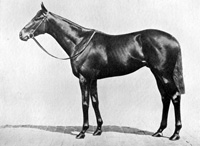 Manna Photograph by W W Rouch © Thoroughbred  James J Maher (1863-1935), a prominent bloodstock breeder and popular sportsman, began with jumpers and then encompassed flat racers. He bred winners of both the Grand National Steeplechase and the Derby Stakes, a unique achievement. |
Manna b c 1922 (Phalaris - Waffles,
by Buckwheat). Family 22-d. Bred in Ireland by James J Maher from his mare Waffles, Manna was brother to the City and Suburban winner Parwiz (b c 1925 Phalaris) who made a name for himself as a stallion in Argentina, and the St Leger winner Sandwich (b c 1928 Sansovino). Waffles never ran and was said to stand "barely 15 hands". Another of her foals was the dimunitive Bunworry (b f 1921 Great Sport) who went to Italy, via India, and became the ancestress of a host of Italian luminaries. Manna was sold at the 1923 Doncaster sales for 6300gs to Fred Darling for Henry E Morriss, a bullion broker, who also purchased the Banstead Manor Stud. Manna was described as medium-sized, beautifully made and "full of the St. Simon quality and vitality". |
|||||||||||||||||||||||||||||||||||||||||
|
|
||||||||||||||||||||||||||||||||||||||||||
|
||||||||||||||||||||||||||||||||||||||||||
|
|
||||||||||||||||||||||||||||||||||||||||||
| Manna's turf career spanned 2 years
and 9 races, of which he won 4. He came out his last race, the St Leger,
having sustained a sprain in his off-foreleg which ended his racing. In 1924 he finished 3° for the National Breeders' Produce Stakes at Sandown Park, won by Garden Of Allah (b f 1922 Golden Sun). His first win came next, the Richmond Stakes at Goodwood, beating Field Argent (b c 1922 Phalaris) by 6 lengths. He then finished 2° for the Imperial Produce Stakes at Kempton Park, won by Picaroon (br c 1922 Beppo) and 3° for the Middle Park Stakes, won by Picaroon, with Solario (b c 1922 Gainsborough) in for 2° place. In his last outing of the year he won the Moulton Stakes, beating Inca (ch f 1922 Invincible) by 3 lengths. In 1925 he won the Two Thousand Guineas Stakes, beating St. Becan (br c 1922 Hurry On) by 2 lengths, Oojah (ch c 1922 Bachelor's Double) and Solario. Others among the vanquished included the King's Runnymede (b c 1922 Hurry On), Foxlaw (br c 1922 Son-In-Law) and the Irish Derby winner Zionist (b c 1922 Spearmint). His next win came in the Derby Stakes at Epsom when he defeated Zionist by 8 lengths and the French-bred The Sirdar (br c 1922 McKinley), along with Solario, Runnymede and Ethnarch (gr c 1922 The Tetrarch). In his next outing he gave 10 pounds to Solario and Sparus (b c 1922 Gainsborough) and lost the Ascot Derby to both of them, finishing 3°. In his final race he was among the field for the St Leger at Doncaster, won by Solario, Zambo (bb r 1922 Sunstar) and Warden Of The Marches (ch c 1922 Phalaris). Manna initially retired to the Coombe Park stud of Charles Howard, near Pangbourne, but later removed to his owner's Banstead Manor Stud, at Cheveley, near Newmarket. He covered for a fee of 400gs. |
||||||||||||||||||||||||||||||||||||||||||
|
||||||||||||||||||||||||||||||||||||||||||
| His most notable offspring was the
Two Thousand Guineas winner Colombo (b c 1931), see below. Other of his
sons, dispersed to vastly different places, also did well. Mannamead (br
c 1929) won the Rous Memorial Stakes, went to Hungary and there led the
sires list in 1943 and 1944. Manitoba (b c 1930) won the Coventry Stakes
in England and was then sent to Australia where he led the sires list
for two seasons, in 1943-44 and 1944-45. However, it was his daughter Archidamia
(b f 1933), winner of the Italian One Thousand and Two Thousand Guineas,
of the Italian Oaks and Derby, who made him the leading stallion in
Italy in 1936. Manna died October 12, 1939, at the age of seventeen. |
||||||||||||||||||||||||||||||||||||||||||
| Colombo (GB) | ||||||||||||||||||||||||||||||||||||||||||
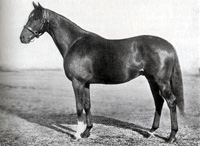 Colombo  Sir Alec Black (1872-1942), 1st Bt of Louth Park, was awarded his title for the innovative use of his Grimsby trawler fleet as minesweepers during WW I. Between 1922 and 1939 he bred the winners of 142 races. |
Colombo b c 1931 (Manna - Lady
Nairne, by Chaucer). Family 11-f. Bred by Sir Alec Black, Colombo was from an unraced mare, whom Sir Alec acquired for 6200gs, who was half sister to the Two Thousand Guineas winner Ellangown (b c 1920 Lemberg). Sir Alec dispersed his Compton Park Stud in 1931 and William James Tatem (1868-1942), 1st Baron Glanely, acquired Colombo for 510gs at the Doncaster Sales of 1932. |
|||||||||||||||||||||||||||||||||||||||||
|
|
||||||||||||||||||||||||||||||||||||||||||
|
||||||||||||||||||||||||||||||||||||||||||
|
|
||||||||||||||||||||||||||||||||||||||||||
| Colombo ran for two years,
being unbeaten as a two year old, winning all 7 of his races, and
counting the Two Thousand Guineas as one of his 2 wins from 4 races as a
three year old. A great controversy erupted over his loss in Derby, and
as might be expected, the jockey was blamed. W R Johnstone, had been
engaged by Lord Glanely at the beginning of 1934 and his previous
experience in Austalia, India and as premier jockey in France had left
him unprepared for the difficult, tricky nature of the Epsom course. He
found himself hopelessly stuck on the rails at Tattenham Corner behind
Medieval Knight who was slowing. By the time he had extricated Colombo
he was far behind and had only 2 furlongs left. Nevertheless he made up
the ground in the next furlong but had nothing left to pass the leaders. In 1933, running unnamed, he won the First Spring Two Year Old Stakes at Newmarket, beating the One Thousand Guineas winner Campanula (b f 1931 Blandford) by a head and Merenda (b f 1931 Blandford). Newly named he won the Scarborough Sweepstakes at York, beating Black Vine (br f 1931 Black Watch) by 4 lengths, and Wardley (ch g 1931 Tetrameter). He next won the New Stakes (now called Norfolk Stakes) at Ascot Heath, beating Valerius (b c 1931 Son-In-Law) by 2 lengths, and Alishah (gr c 1931 Tetratema). Then came the Fulbourne Stakes at Newmarket, in which he defeated Mystery Ship (b f 1931 Buchan) by 4 lengths, and Flamenco (b c 1931 Flamingo). He won the National Breeders' Produce Stakes at Sandown Park, beating Silver Araby (gr f 1931 Tetratema) by a length and a half, and Valerius. He won the Richmond Stakes at Goodwood beating the Middle Park Stakes winner Medieval Knight (b c 1931 Gay Crusader) by 3 lengths, and John James (br c 1931 Buchan) a future down-under stallion; the future Two Thousand Guineas and Derby winner Windsor Lad (b c 1931 Blandford) was among the field. In his last race of the year he won the Imperial Produce Stakes at Kempton Park, beating Valerius by a short head, and Achtenan (b c 1931 Achtoi). In 1934 he won the Craven Stakes (1m) at Newmarket, beating Osman Pasha (br g 1921 Blandford) by 4 lengths, and Pharillon (ch c 1931 Phalaris), a full brother to Pharos and Fairway. He won the Two Thousand Guineas Stakes, beating the French-bred Easton (b c 1931 Dark Legend) by a length, another French-bred, Badruddin (gr c 1931 Blandford), and among others, Valerius, Medieval Knight and Umidwar (b c 1931 Blandford). He lost the Derby to Windsor Lad by a length, with Easton taking 2° by a neck, the French-bred Admiral Drake (b c 1931 Craig An Eran) was among the also-rans. In his final race he finished 2° by half a length for the St James's Palace Stakes at Ascot Heath, won by Flamenco. A month before the St Leger Colombo injured a knee whilst in his box and his racing days were over. He retired to his owner's Exning Stud at Newmarket where he took up duties with Singapore (b c 1927 Gainsborough), both books were full for 1935, at 300gs each. Lord Glanely died in 1942 and his entire stock was purchased for £115,000 by A E Allnat who resold most of them the next year. He kept Colombo and 2 others for himself and then syndicated Colombo for £24,000, retaining 10 shares, upon which he was sent to the Cheveley Park Stud. He was later sold to E H Clovell and covered at the Southdown Stud for a fee of £98. |
||||||||||||||||||||||||||||||||||||||||||
|
||||||||||||||||||||||||||||||||||||||||||
| In the stud
Colombo got some very good mares, notably Olein (b f 1936) who won the
Coronation Stakes, was sold for a record 17,000gs and subsequently bred
5 winners of 17 races. He also got several good runners, including Happy
Knight (b c 1943) who won the Two Thousand Guineas, and Claro (b c
1943), a winner of the Irish Two Thousand Guineas and later a good
stallion in Argentina. Probably his most influential offspring was
British Empire (br c 1937), a winner of the July Stakes and later a
highly successful stallion, also in Argentina, where he was champion
sire in 1947 and 1954. Colombo died in March, 1954, in the Southdown Stud, Sussex, at the age of 23 years. |
||||||||||||||||||||||||||||||||||||||||||
| Colorado (GB) | ||||||||||||||||||||||||||||||||||||||||||
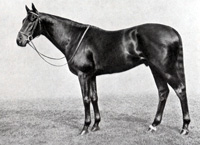 Colorado Photograph by W A Rouch © Thoroughbred  Canyon Photograph by W A Rouch © Thoroughbred |
Colorado br c 1923 (Phalaris -
Canyon, by Chaucer). Family 3-l. Bred by the 17th Earl Of Derby from his One Thousand Guineas winner Canyon, Colorado was a full brother to the Eclipse Stakes winner Caerleon (br c 1927). He stood less than 15 hands 3 inches when he ran as a three year old and was described as having a "somewhat sturdier appearance than Manna, for he is particularly well muscled at all essential points," and possessed of "exquisite quality, a trait that Phalaris transmits to most of his stock". |
|||||||||||||||||||||||||||||||||||||||||
|
|
||||||||||||||||||||||||||||||||||||||||||
|
||||||||||||||||||||||||||||||||||||||||||
|
|
||||||||||||||||||||||||||||||||||||||||||
| Colorado ran for 3 years, winning 9
of his 16 races including the Two Thousand Guineas defeating the
favourite, Coronach (ch c 1923 Hurry On), and finished 3° for the Derby.
His Guineas win came as a slight surprise as he had, according to his
trainer Mr Lambton, a "rattling in his throat and he blew in alarming
fashion" at a previous trial. In his first race he won the Lodge Maiden Two Years Old Plate at Manchester, beating Happy Recruit (br c 1923 Happy Warrior) by 4 lengths. He did the same in his next race, the Coventry Stakes at Ascot Heath, beating Jessel (b c 1923 Polymelus) by 3 lengths and Apple Sammy (b c 1923 Pommern) by 5 lengths. He was then unplaced for the Exeter Stakes at Newmarket, won by Swift And Sure (b c 1923 Swynford) and the French-bred Finglas (b c 1923 Bruleur). He did no better for the Hurst Park Great Two Year Old Stakes, won by Bella Minna (ch f 1923 Bachelor's Double), future mother of Italian Derby winner Bellini (b c 1937 Cavaliere D'Arpino), and Rosehearty (gr c 1923 Stefan The Great). In 1926, he won the Union Jack Stakes at Liverpool, beating Water Melon (br c 1923 Lemonora) by 8 lengths. He then won the Two Thousand Guineas, beating the Derby and St Leger winner Coronach by 5 lengths, Apple Sammy and the Irish Derby winner Embargo (br c 1923 Argosy). He finished 3° for his next 2 starts - the aforementioned Derby won by Coronach and Lancegaye (b c 1923 Swynford), and the Rous Memorial at Ascot, won by Warden Of The Marches (ch c 1922 Phalaris) and Bella Minna. In 1927 he was unplaced for the Newbury Spring Cup, won by Orbindos (b c 1923 Flying Orb), and the Kempton Park Great Jubilee, won by Abbot's Speed (br c 1923 Abbots Trace). He then won his next 5 races, the first of which was the 7f Rous Memorial Stakes at Ascot, beating Valois (ch c 1924 Poltava) by 8 lengths. The next was the 12f Newbury Summer Cup, beating Grassmoor (b c 1923 Phalaris) by 4 lengths, followed by the 12f Princess Of Wales's Stakes at Newmarket, beating the favoured Coronach by 8 lengths. Then came the 10f Eclipse Stakes at Sandown Park, where he beat Mario (b g 1924 Buchan) by 6 lengths and Coronach, and the 10f Eglinton Plate at Windsor, where he beat Park Mill (br f 1923 Coriander) by 2 lengths. In his final race he finished 2° for the Champion Stakes, won by Astérus (b c 1923 Teddy). |
||||||||||||||||||||||||||||||||||||||||||
|
||||||||||||||||||||||||||||||||||||||||||
| He retired to
his owner's Side Hill Stud at Newmarket, with a full book for 1928. Some
of his more notable offspring include Furrokh Siyar (ch c 1929),
Loaningdale (b c 1929), the July Stakes winner Riot (ch f 1929), Cañon
Law (b c 1930), Coloramo (b c 1930) a sire of two derby winners in
Denmark, Coroado (br c 1930), the Ascot Gold Cup winner Felicitation (b
c 1930) who beat Hyperion (ch c 1930 Gainsborough), and Ringmaster (br c 1930) a stallion in New Zealand. Colorado died in September, 1929, after only two seasons in the stud. |
||||||||||||||||||||||||||||||||||||||||||
| Fairway (GB) | ||||||||||||||||||||||||||||||||||||||||||
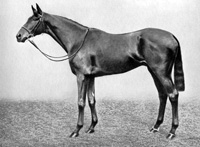 Photograph by W A Rouch © Thoroughbred |
Fairway ch c 1925 (Phalaris - Scapa
Flow, by Chaucer). Family 13-e. Bred by the 17th Earl from a mare who ran in 2 selling races at the beginning of her 3 year old year, Fairway was a full brother to Pharos and a half brother to the Chester Cup winner Spithead (ch g 1919 John O'Gaunt). Scapa Flow later won three small races, all at 12 furlongs. Lord Derby had purchased his 2° dam, Anchora, from George Edwardes for 1300gs at the Newmarket Second Spring Meeting of 1912. She ran in 51 races over 6 years, winning 7 and managing 2° place in both the Manchester November Handicap and the Ebor Handicap. She was sent to France in 1920, where Lord Derby was ambassador from 1918 until 1922. In contrast to other offspring of Phalaris, Fairway was "long and rangy" and thought to take after his grandsire Polymelus. |
|||||||||||||||||||||||||||||||||||||||||
|
|
||||||||||||||||||||||||||||||||||||||||||
|
||||||||||||||||||||||||||||||||||||||||||
|
|
||||||||||||||||||||||||||||||||||||||||||
| Trained by Frank Butters, who
replaced George Lambton when he became Lord Derby's racing manager,
Fairway ran for 3 years, starting 15 times and winning 12 of these
times. His earnings amounted to £42,452. He did not start for the Two
Thousand Guineas due to an abcess in his mouth and lost the Derby before he
got the post due to an unruly crowd who mobbed him and pulled handfuls
of hair from his tail. Frank Butters later said he looked "as if he had
been dragged through a pond". He won from 5 furlongs to 2 miles and 2
furlongs. In 1927 in his first race Fairway was unplaced for the Eglinton Stakes at York, won by Grandmaster (b c 1925 Grand Parade). He won his next three, starting with the Coventry Stakes at Ascot Heath, beating Caraquette (b f 1925 Syndrian) by 3 lengths, and Speyside (ch c 1925 Spion Kop). Next he won the July Stakes, beating Hakim (br c 1925 Friar Marcus) by a head, and Jurisdiction (b f 1925 Abbots Trace). In his last outing for the year he won the Champagne Stakes at Doncaster, beating Nance (br f 1925 Buchan) by 2 lengths, and Cyclonic (ch c 1925 Hurry On), who was later a stallion in the Soviet Union. In 1928 he won the Newmarket Stakes, beating The Wheedler (bbr g 1925 Orpheus) by 2 lengths, before being among the field for the Derby, although starting favourite, won by Felstead (b c 1925 Spion Kop) and Flamingo (b c 1925 Flamboyant). He went on to win three in a row, starting with the Eclipse Stakes at Sandown Park, beating Royal Minstrel (gr c 1925 Tetratema) by 8 lengths and the 1927 St Leger winner Book Law (b f 1924 Buchan). An objection was lodged by The Wheedler, but Mr Weston on Fairway explained that he had bumped The Wheedler because the horse in front of him was stopping very quickly, and was "severely cautioned" in consequence. He then won the St Leger by a length and a half, beating Palais Royal (ch c 1925 Bruleur) and Cyclonic. In his last race for the year he won the Champion Stakes by a neck, beating Foliation (ch f 1923 Tracery) and Irish Derby winner Baytown (gr c 1925 Achtoi). In 1929 he won the Burwell Stakes by a length, beating Silver Spoon (b c 1925 Silvern), followed by the Rous Memorial by a length and a half, beating Winton (b c 1926 Craig An Eran). He next won the Princess Of Wales's Stakes, beating Cyclonic, and Athford (b c 1925 Blandford). He then finished 2° for the Eclipse Stakes at Sandown Park, won by Royal Minstrel (gr c 1925 Tetratema), beating Parwiz (b c 1925 Phalaris). Then he won the Champion Stakes for the second time, beating Cyclonic by 3 lengths. He also won his last race, the Jockey Club Cup, beating Palais Royal by 3 lengths, and Saracen (b c 1925 Gay Crusader). |
||||||||||||||||||||||||||||||||||||||||||
|
||||||||||||||||||||||||||||||||||||||||||
| He retired to his owner's
Woodland Stud at Newmarket with a full book for 1931. His fee was 400gs
which was reduced during WW II. He was immensely successful in the stud,
getting 2 Derby winners, Blue Peter (ch c 1936), who also won the Two
Thousand Guineas, and Watling Street (b c 1939). He also got Two
Thousand Guineas winners Pay Up (br c 1933), Kingsway (br c 1940) and
Garden Path (bbr f 1941) and One Thousand Guineas winner Tide-Way (br f
1933). Other notable offspring include Fair
Trial (ch c 1932), Fairhaven (ch c 1932), Hairan (b c 1932), Fair Copy
(br c 1934), Portmarnock (bc 1935) and Honeyway (br c 1941). He was Champion sire in 1936, 1939, 1943 and 1944, and Champion Broodmare Sire in 1946 and 1947. Fairway was pensioned in 1945. He was beset by paralysis in his hindquarters and humanely destroyed in 1948. |
||||||||||||||||||||||||||||||||||||||||||
| Fair Trial (GB) | ||||||||||||||||||||||||||||||||||||||||||
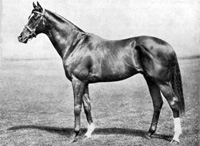  John Arthur "Lucky" Dewar (1891-1954), inherited £1,000,000, a two-thirds interest in a £2,500,000 trust fund, a stud and a string of racehorses from his uncle, 1st Baron Dewar, and was thenceforth known as "Lucky". His racehorses included Cameronian who won him the Derby, and Lady Juror who bred Fair Trial. |
Fair Trial ch c 1932 (Fairway - Lady
Juror, by Son-In-Law). Family 9-c. Bred by J A Dewar in his Homestall Stud at East Grinstead, Sussex, Fair Trial was from a half sister to Mumtaz Mahal (gr f 1921 The Tetrarch) whom his uncle had purchased from the estate of Lord Manton for 8600gs. His pedigree might suggest he was bred to be a stayer, given that he was sired by a St Leger winner out of a Son-In-Law mare. |
|||||||||||||||||||||||||||||||||||||||||
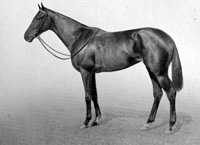 Lady Juror, Photograph by W A Rouch © Thoroughbred |
||||||||||||||||||||||||||||||||||||||||||
|
|
||||||||||||||||||||||||||||||||||||||||||
|
||||||||||||||||||||||||||||||||||||||||||
|
|
||||||||||||||||||||||||||||||||||||||||||
| Trained by Fred Darling, he was
thought so backward as a two year old that he was never even galloped
until he was three. As well, he was plagued by a combination of shelly
feet and suspect knees. He was withdrawn from the St Leger when he
succumbed to the ravages of a coughing epidemic. In his final race he
damaged a hind tendon which gave out completely shortly thereafter. His
turf career was short, but established him as one of the finest milers
in the country. He won 7 races of 9, finishing 2° and 3° in the other
two, earning £5,100. In 1935 he won the Longleat Stakes at Salisbury by 3 lengths, beating Milldoria (bbr f 1932 Milton) and Duvernate (br c 1932 Obliterate). He next won the Queen Anne Stakes at Ascot Heath by 3 lengths, beating Solerina (br f 1932 Soldennis) and the French-bred Monico (br c 1932 Gaurisankar). He followed this with a 3° place finish in the Eclipse Stakes, won by the Derby and St Leger winner Windsor Lad (b c 1931 Blandford) and Theft (b c 1932 Tetratema). After this he won the Select Stakes, beating Almond Hill (b f 1931 Craig An Eran) and The Blue Boy (gr c 1930 Gainsborough), and the Ormonde Plate at Newbury, beating Joshua (br c 1932 Solario) and Snaefell (br g 1932 Felstead). In 1936 he won the Spring Plate, beating Bobsleigh (ch c 1932 Gainsborough) and Rippon Tor (b c 1932 Lightning Artist) and then finished 2° for the March Stakes, won by Plassy (b c 1932 Bosworth), beating 'Appy (ch g 1933 Apelle). He won his next start, the Rous Memorial at Ascot Heath, beating Jubie (b c 1933 Biribi) and Joshua. He also won his last race of the year, and as it turned out the last race of his career, the Lingfield Park Plate, beating the future St Leger winner Boswell (br c 1933 Bosworth) by 6 lengths over a mile, in which he strained a hind tendon. |
||||||||||||||||||||||||||||||||||||||||||
|
||||||||||||||||||||||||||||||||||||||||||
| He retired to his owner's Homestall
Stud with a fee of 198gs, which was reduced during the war to 148gs, and
afterwards rose to 300gs. His book remained full throughout. Following
the death of Mr Dewar in 1954 he went to the Warren Stud. His best earner was the Aga Khan's Palestine (gr c 1947) who won the Two Thousand Guineas Stakes. He also got Petition (bbr c 1944), who won he Eclipse Stakes and was after a Champion sire in England in 1959, and Court Martial (ch c 1942), a winner of the Two Thousand Guineas and Champion Stakes before becoming Champion sire in England in 1956 and 1957. Fair Trial was Champion sire in Ireland in 1945, Champion sire in England in 1950 and Champion broodmare sire in England in 1951. He died in 1958. |
||||||||||||||||||||||||||||||||||||||||||
| Blue Peter (GB) | ||||||||||||||||||||||||||||||||||||||||||
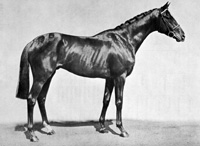 Blue Peter Photograph by W A Rouch © Thoroughbred  Albert Edward Harry Meyer Archibald Primrose (1882-1974), 6th Earl Of Rosebery, maintained that Blue Peter was the best horse he ever bred. He also bred Blue Peter's son, Ocean Swell, who captured the wartime substitutes for the Derby and the Gold Cup, both of which were held at Newmarket. |
Blue Peter ch c 1936 (Fairway - Fancy
Free, by Stefan The Great). Family 20-c. Bred by the 6th Earl Of Rosebery, Blue Peter was foaled in the Mentmore Stud and except for his time at Newmarket he remained there his entire life. His dam, Celiba, bred in county Limerick by Mrs Blanche Bailey, was purchased by Lord Wimbourne as a yearling for 3,000gs. She won 4 small races worth £2,447 from 24 starts including the 10 furlong Hurst Park Whitsuntide Handicap. Lord Rosebery obtained her as a four year old, in foal, from the Wimbourne bloodstock dispersal. Blue Peter was a younger full brother to Full Sail (b c 1934) who later became a leading stallion in Argentina, and a half brother to Neptune (b c 1938 Hyperion) who was most successful in New Zealand. He was described as a "handsome horse, with plenty of substance though perhaps a little too long behind the saddle". Before the Derby he was measured at a hair over 16 hands with a girth of 74 inches and 8 inches of bone. |
|||||||||||||||||||||||||||||||||||||||||
|
|
||||||||||||||||||||||||||||||||||||||||||
|
||||||||||||||||||||||||||||||||||||||||||
|
|
||||||||||||||||||||||||||||||||||||||||||
| He was trained at Newmarket by Jack
Jervis, and both trainer and owner thought sufficiently highly of him to
go easy on him as a two year old. He started only twice, finishing 2°
for the Middle Park Stakes yet inspring confidence that he could go on
to win the Derby. He was unbeaten at three, winning the 2000 Guineas,
although there was concern that the distance was on the short side for
him. He easily won the Derby and the Eclipse Stakes. He was thought
unlucky to have missed the St Leger, which was not run in 1939 as WW II
was declared on September 3 and the meeting at Doncaster was abandoned.
He ran only 6 times, winning 4 of those, for earnings of £31,963. In 1938 he was unplaced for the Imperial Produce Stakes at Kempton Park, won by Heliopolis (b c 1936 Hyperion) and Casanova (ch c 1936 Hyperion). However, he finished 2° in his next race, the Middle Park Stakes, won by the American-bred Foxbrough (b c 1936 Sir Gallahad), beating Rogerstone Castle (gr c 1936 Mr. Jinks). In 1939 he won the Blue Riband Trial Stakes at Epsom by 4 lengths, beating Diadoque (b c 1936 Blandford) and Fairfax (br c 1936 Fairway). He then won the Two Thousand Guineas by half a length, beating Admiral's Walk (ch c 1936 Hyperion) and Fairstone (ch c 1936 Fairway). Next he won the Derby, for which he started favourite, by 4 lengths, beating Fox Cub (ch c 1936 Foxhunter) and Heliopolis. In his final race he won the Eclipse Stakes at Sandown Park by a length and a half, beating Glen Loan (b c 1935 Loaningdale) and Challenge (ch c 1935 Apelle). In the stud he got a Derby winner in his first crop, Ocean Swell (b c 1941), who also won the Gold Cup at Ascot, the first to do so since Persimmon (b c 1893 St. Simon) in 1896. He got another Gold Cup winner with the Italian triple crown winner Botticelli (b c 1951), who spent his later years in Germany. His best earner was Peter Flower (b c 1946) who was sent to America. |
||||||||||||||||||||||||||||||||||||||||||
|
||||||||||||||||||||||||||||||||||||||||||
| Other notable offspring include Blue Train (ch c 1944)
who was later a stallion in Ireland, and Masthead (b c 1944) who was a
successful stallion in Australia. His daughters were well regarded. Glen Line (b f 1942) produced the Two Thousand Guineas winner Our Babu, and the Eclipse Stakes winner King Of The Tudors. Blue Gem (b f 1943) produced the Portland Handicap winner Princely Gift. Blue Peter was the Champion broodmare sire in 1954. He was humanely destroyed after suffering a heart attack on December 11, 1957. |
||||||||||||||||||||||||||||||||||||||||||
| Sickle (GB) | ||||||||||||||||||||||||||||||||||||||||||
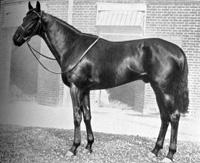 Sickle Photograph by W A Rouch © Thoroughbred  Selene |
Sickle br c 1924 (Phalaris - Selene,
by Chaucer). Family 6-e. Bred by the 17th Earl Of Derby, he was a full brother to Pharamond (br c 1925) and a half brother to the mighty Hyperion (ch c 1930 Gainsborough). His dam, the petite Selene, did not contest any classics although she ran for 2 years, winning 8 from 11 at 2, and 8 from 11 at 3, including the Cheveley Park Stakes and the Park Hill Stakes at Doncaster. She bred 10 winners of 30 races worth £47,345. Sickle was her first foal. He was described as a "medium-sized colt of good quality". |
|||||||||||||||||||||||||||||||||||||||||
|
|
||||||||||||||||||||||||||||||||||||||||||
|
||||||||||||||||||||||||||||||||||||||||||
|
|
||||||||||||||||||||||||||||||||||||||||||
| Trained by George Lambton, Sickle ran
for two years, winning three races from 10 starts. In 1926 he finished 2° for the New Stakes at Ascot Heath, won by Damon (gr c 1924 Stefan The Great), beating Adam's Apple (b c 1924 Pommern). He next finished 2° for the July Stakes, won by The Satrap (gr c 1924 The Tetrarch), beating Call Boy (ch c 1924 Hurry On). He won the Mersey Stakes at Liverpool by 6 lengths, beating Golden Ode (br f 1924 Orpheus). He followed this with a 5 length win in the Prince Of Wales's Stakes at Goodwood, beating Casino (b c 1924 Pommern) and The Brown Talisman (br c 1924 Torelore). He then finished 3° for the Champagne Stakes at Doncaster, won by Damon and Call Boy. Next he won the Boscawen (Post) Stakes, beating Casino and Treat (b c 1924 Tetratema). In his final outing for the year he finished 2° for the Middle Park Stakes, won by Call Boy, beating Birthright (bbr c 1924 Swynford). In 1927 he finished 2° for the Union Jack Stakes at Liverpool, won by Buckfast (br c 1924 Buchan). He then finished 3° for the Two Thousand Guineas, won by Adam's Apple and Call Boy. He was among the field for the Derby Stakes, won by Call Boy and Hot Night (b c 1924 Gay Crusader). He was said to have jarred a pastern in the Derby and never ran again. He entered Lord Derby's stud for 1929 (and got 6 winners), then was leased for three years, with an option to purchase, to Jospeh E Widener of the Elmendorf Farm at Lexington. Widener's wife had died that year and a provision of her will left him $100,000 to acquire a stallion. He used his option and purchased Sickle in October of 1932. His stud fee was set at $1,000 for 1933. He proved a successful stallion, getting 45 stakes-winners from 297 foals. His most successful runner was Santa Anita Derby winner Stagehand (b c 1935) who earned $200,110 and became champion three year old colt in 1938 and the only horse in history to win Santa Anita's Derby and Handicap in the same year. He had another champion in the two year old colt Star Pilot (br c 1943) who won both the Hopeful and Futurity Stakes in 1945, and Cravat (b c 1935) a winner, among several other major stakes races, of the 2 mile 1939 Jockey Club Gold Cup, his sire and grandsire's reputations as inferior sources of stamina notwithstanding. Cravat's full sister, multiple stakes-winner Jabot (ch f 1931), was one of Sickle's several talented fillies. Bred truer to the paternal model by aptitude, her preferred distance at maturity was 6-8f. Jabot went on to produce the 1951 Horse of the Year and champion 3yo for 1951, Counterpoint (ch c 1948 Count Fleet). Sickle's best home-bred daughter was the multiple stakes winner Misty Isle (ch f 1938), a favorite performer on the midwestern circuit. Arlington race track in Illinois ran a Misty Isle stakes for over 50 years. Sickle's top earning daughter Brownian (bbr f 1944) finished 2° in the 1947 Misty Isle Stakes. |
||||||||||||||||||||||||||||||||||||||||||
|
||||||||||||||||||||||||||||||||||||||||||
| Sickle's top producing daughter, The Squaw II (b f 1939) was
a Widener-bred, foaled at her owner's farm in France. After her most
eventful early years on the continent she was brought to the United
States where she produced two classic winning fillies by Princequillo. Bred to her sire's great-grandson Native Dancer, Sickle's daughter
Vixenette (ch f 1944) got Dan Cupid (ch
c 1956) a stakes-winning stayer and popular sire in France. The
only son that came anywhere close to Sickle's performance as sire was
the 1937 Latonia Derby winner Reaping Reward (b c 1934), half-brother to Whirlaway
(ch c 1938 Blenheim). The offspring of Sickle won more than $1,500,000. Nevertheless, his major contribution to the world of bloodstock breeding was his son Unbreakable and the descent to Polynesian, Native Dancer and Raise A Native to Mr. Prospector, one of the preeminent stallions of the 20th century. He was a Leading Sire in America in 1936 and 1938. Sickle died the day after Christmas in December of 1943. |
||||||||||||||||||||||||||||||||||||||||||
| Unbreakable (USA) | ||||||||||||||||||||||||||||||||||||||||||
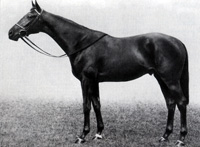 Unbreakable Photograph by W A Rouch © Thoroughbred  Joseph Early Widener (1871 - 1943), a well-known figure on the turf, purchased Elmendorf Farm in Kentucky just after WW I. He was also associated with Belmont Park and Hialeah Park race courses. As well, he was a noted figure on the French turf and kept a number of mares at Haras Du Mesnil. |
Unbreakable bl c 1935 (Sickle - Blue
Glass, by Prince Palatine). Family 4-i. Bred in the Elmendorf Stud at Lexington by Joseph E Widener, Unbreakable was a half brother to the Belmont Stakes winner Hurryoff (b c 1930 Haste). Their 4° dam, Hauteur (br f 1880 Rosicrucian) was a fine winner in England of the 1000 Guineas Stakes and the Champagne Stakes. |
|||||||||||||||||||||||||||||||||||||||||
|
|
||||||||||||||||||||||||||||||||||||||||||
|
||||||||||||||||||||||||||||||||||||||||||
|
|
||||||||||||||||||||||||||||||||||||||||||
| Sent to England, Unbreakable did all
his racing there. He was trained by Captain (later Sir) Cecil Boyd-Rochfort
at Newmarket. As a two year old he won the Exeter, Soltykoff and
Richmond Stakes, as a three year old he won the Waterford Stakes, and as
a four year old he won the Victoria Cup. In 1937 he finished 2° for the Zetland Plate at York, won by Hoity-Toity (b f 1935 Beresford), beating Reflection (br g 1935 Orwell). He then finished 3° for the Windsor Castle Stakes at Ascot Heath, won by Scotia's Glen (b f 1935 Beresford) and Far West (b g 1935 Fairway). Next he won the Exeter Stakes by 2 lengths, beating Saintly (b f 1935 Miracle) and Agincourt (br c 1935 Bosworth). He also won the Soltykoff Stakes by 3 lengths, beating the Gimcrack Stakes winner Golden Sovereign (br c 1935 Monarch) and Kentish Emblem (ch c 1935 Sandwich). He had another win by 3 lengths for the Richmond Stakes at Goodwood, beating the two French-breds, Pactolus (ch c 1935 Pharos) and Khan Bahadur (ch c 1935 Blenheim). In his last outing of the year he finished 3° for the Middle Park Stakes, won by the future St Leger winner Scottish Union (br c 1935 Cameronian) and the French-bred Mirza (br c 1935 Blenheim). In 1938 he was among the field for the Coventry Stakes at Kempton Park, won by Pasch (b c 1935 Blandford) and The Tweed (b c 1935 Salmon Leap). He was also among the field for the Two Thousand Guineas, won by Pasch and Mirza. He had no better luck in the Derby, won by the French-bred Bois Roussel (br c 1935 Vatout) and Pasch. He then won the 1 mile Waterford Stakes at Ascot by 2 lengths, beating The Bittern (br f 1935 Flamingo) and Slip In (b c 1935 Slipper). He next finished 2° for the 1 mile 2 furlong Knowsley Dinner Stakes at Liverpool, won by Hesperian (b c 1935 Colorado), beating Sly Abbess (ch f 1935 Foxlaw). He also finished 2° for the 1 mile Sussex Stakes at Goodwood, won by Faröe (ch c 1935 Sansovino), beating Deanslaw (b c 1935 Foxlaw). In 1939 he was unplaced for the 1 mile 2 furlong City And Suburban Handicap at Epsom, won by Bistolfi (b c 1935 Singapore) and the French-bred Mormond Hill (br c 1934 Brumeux). In his last race in England he won the 7 furlong Victoria Cup at Hurst Park, beating Pegasus (b g 1931 Pommern) and the French-bred future Cambridgeshire winner Quartier-Maitre (ch g 1935 Monarch). In 1940 he was sent home to America and entered the stud at Elmendorf. He was said to have received only moderate patronage. His best earners were Polynesian (1942) $310,410, Inseparable (1945) $239,542 and Sturdy One (1947) $202,970. His outstanding son was the Elmendorf-bred Polynesian (br c 1942), winner of the Preakness Stakes, a Champion Sprinter in 1947, and the sire of the legendary Native Dancer (gr c 1950). After the death of Mr Widener Unbreakable was sold to a syndicate in which Elmendorf Farm held a controlling interest. Unbreakable died in August of 1952 at Elmendorf Farm. |
||||||||||||||||||||||||||||||||||||||||||
| Polynesian (USA) | ||||||||||||||||||||||||||||||||||||||||||
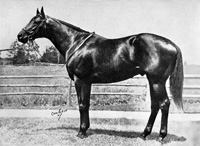 Polynesian  Gertrude T Douglas Widener (1897-1970) was prominent on the French turf with such horses as Dan Cupid, sire of the immortal Derby winner Sea-Bird, Prix Morny winner Grey Dawn and the Champion French Two Year Old Filly Hula Dancer, winner of the 1000 Guineas. |
Polynesian br c 1942 (Unbreakable -
Black Polly, by Polymelian). Family 14-a. Bred in Kentucky by Elmendorf Farm, Polynesian was an anniversary present from P A B Widener II (1895-1948) to his wife, Gertrude. Black Polly (b f 1936 Polymelian), dam of Polynesian, was a modest performer winning one of her three starts. She had only one foal prior to Polynesian and died several weeks after his birth. He was hand raised. He was described as a "medium-sized colt of great quality" and "in physical appearance... hard to fault," with powerful shoulders and forearms, long, well -tapered croup and thighs, very intelligent head and wide between the eyes. "His strong, sturdy frame is well set over legs that are straight and powerful in appearance". |
|||||||||||||||||||||||||||||||||||||||||
|
|
||||||||||||||||||||||||||||||||||||||||||
|
||||||||||||||||||||||||||||||||||||||||||
|
|
||||||||||||||||||||||||||||||||||||||||||
| Polynesian was trained by Morris
H Dixon and ran from two to five years. He won five of his races as a two
year old, five at three, eight at four, and nine at five. His lifetime
record was a respectable 58-27-10-10 with earnings of $310,410. Some of his more important victories include, at 2, the Sagamore Stakes, at 3, the Withers Stakes and the Preakness Stakes, at 4, the Toboggan Handicap, Roseben Handicap, Rumson Handicap, Pageant Handicap, Scarsdale Handicap, Riggs Handicap, and the Turf and Field Handicap, and at 5, the Atlantic City Inaugural Handicap, Wilmington Handicap, Oceanport Handicap, Long Branch Handicap, Omnibus Handicap, Camden Handicap and Janney Handicap. |
||||||||||||||||||||||||||||||||||||||||||
|
|
||||||||||||||||||||||||||||||||||||||||||
|
||||||||||||||||||||||||||||||||||||||||||
|
|
||||||||||||||||||||||||||||||||||||||||||
| He equalled the 6f world record of 1 minute 9
1-5 seconds, and set or equalled five other records up to 1 1-8 miles
under weights of up to 130 pounds. He was the Champion Male Sprinter of
1947 in America. He covered first at Elmendorf, then in 1949 at the Gallaher Farm near Lexington, along with another Preakness winner, Challedon (b c 1936 Challenger). Polynesian led the Sires Of Two Year Olds in 1952, thanks to the victories of Native Dancer. Barbizon (br c 1954) was top Two Year Old Colt in 1956, with lifetime earnings of $199,460. Other good earners were: Polylad ($348,004), Imbros ($340,550), Poly Hi ($160,845), Bureaucracy ($156,635) and Tahitian King ($103,565). In 1954, at the peak of fame for Native Dancer, Polynesian was syndicated for $560,000, a record high for an American stallion. Polynesian died at Gallaher Farm, Lexington, in December of 1959. |
||||||||||||||||||||||||||||||||||||||||||
| Native Dancer (USA) | ||||||||||||||||||||||||||||||||||||||||||
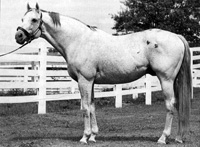  Alfred Gwynne Vanderbilt II (1912-1999) was a member of a prominent and wealthy family. His mother gave him Sagamore Farm in Maryland as a 21st birthday present. A popular personality on the turf he also owned 1935 Horse Of The Year Discovery (ch c 1931 Display). |
Native Dancer gr c 1950 (Polynesian -
Geisha, by Discovery). Family 5-f. "The Grey Ghost Of Sagamore" as he became known was bred and owned by Alfred Gwynne Vanderbilt. He was foaled March 27, 1950 at Dan Scott Farm, Lexington, Kentucky, just across the road from the Gallaher Farm where his sire Polynesian stood. He was a second generation homebred, Mr Vanderbilt having purchased his grandam, Mikayo (gr f 1935 John P. Grier) from Leslie Combs in 1940. His grey colour descended from Roi Hérode (gr c 1904 Le Samaritain), sire of his 4° dam. |
|||||||||||||||||||||||||||||||||||||||||
|
|
||||||||||||||||||||||||||||||||||||||||||
|
||||||||||||||||||||||||||||||||||||||||||
|
|
||||||||||||||||||||||||||||||||||||||||||
|
Trained by Bill Winfrey, he won 21 of 22 starts,
his only loss being a head defeat to Dark Star (br c 1950 Royal Gem) in the Kentucky Derby. His two year old campaign included wins in the Youthful, Flash, Hopeful, Saratoga Special, East View, and Grand Union Hotel Stakes, as well as a world record-equaling performance in the 6.5 furlong Futurity Stakes (1:14 2/5, on a straight course). He was selected Champion Two Year Old by both national polls, with the Thoroughbred Racing Association also naming him Horse of the Year. After starting his three year old season off with wins in the Gotham Stakes and Wood Memorial, he entered the Kentucky Derby as the heavy favorite, but was unable to overcome a troubled trip, and pacemaker Dark Star held him off at the finish. After that he returned to dominance, taking the Withers, Preakness, Belmont, Dwyer, Arlington Classic, Travers and American Derby in short order. In the American Derby he suffered a foot bruise, which ended his season before he could take on older horses. This likely cost him the Horse of the Year title, though he was again the unanimous choice to win his own division. At four, he began showing signs of unsoundness. He made just three starts, only one of which, the Metropolitan Handicap, was a stake. However, he won all three races easily while carrying significant weight, so the brief campaign was enough to earn him the 1954 Champion Handicap Horse and Horse of the Year titles. |
||||||||||||||||||||||||||||||||||||||||||
|
|
||||||||||||||||||||||||||||||||||||||||||
|
||||||||||||||||||||||||||||||||||||||||||
|
|
||||||||||||||||||||||||||||||||||||||||||
| He entered stud in 1955 at his owner's Sagamore Farm in Maryland, where he stood until his death in November 1967. He sired 212 winners from 306 named foals, 44 of them stakes winners, and produced Champions and Classic winners on both sides of the Atlantic, including Kentucky Derby winner Kauai King (br c 1963) and One Thousand Guineas winner Hula Dancer (gr f 1960). | ||||||||||||||||||||||||||||||||||||||||||
|
||||||||||||||||||||||||||||||||||||||||||
| He would become a massive influence on the breed, mainly through (1) his son Raise A Native (b c 1970), he the sire of one of the most influential stallions of 20th century America, Mr. Prospector (b c 1970) and (2) his daughter Natalma (b f 1957), the dam of another legendary stallion, Northern Dancer (b c 1961 Nearctic). | ||||||||||||||||||||||||||||||||||||||||||
| Pharamond (GB) | ||||||||||||||||||||||||||||||||||||||||||
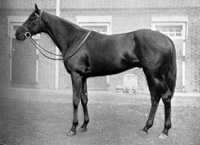  Hal Price Headley (1888-1962) took the reins of Beaumont Farm, near Lexington, from his father in 1908. He helped establish the American Thoroughbred Breeders Association, which group bought The Blood-Horse magazine. He and Major Louie Beard led a group of respected horsemen to establish Keeneland in 1936. He bred 88 stakes winners of nearly $10,000,000. |
Pharamond b c 1925 (Phalaris -
Selene, by Chaucer). Family 6-e. Bred by the 17th Earl of Derby, Pharamond was a full brother to Sickle (br c 1924) and a half brother to Hyperion (ch c 1930 Gainsborough). |
|||||||||||||||||||||||||||||||||||||||||
|
|
||||||||||||||||||||||||||||||||||||||||||
|
||||||||||||||||||||||||||||||||||||||||||
|
|
||||||||||||||||||||||||||||||||||||||||||
| Trained by George Lambton, he ran for
two years winning 2 races from 11 starts, including the prestigious
Middle Park Stakes, with earnings of £3,695 (only first place money is
included). In 1927 he was among the field for the Zetland Plate at York, won by Devastation (b c 1925 Irishman) and Junior Colt (b c 1925). He then finished 3° for the Windsor Castle Stakes at Ascot Heath, won by Sunny Trace (b c 1925 Abbots Trace) and the French-bred Three Star (ch g 1925 Sourbier). He was unplaced for the National Breeders' Produce Stakes at Sandown Park, won by the future Two Thousand Guineas winner Flamingo (b c 1925 Flamboyant) and Jack Mytton (b c 1925 Comrade). Then he finished 2° for the Lancashire Breeders' Produce Stakes at Liverpool, won by Dark Doll (b f 1925 Othello), beating Lawful (b f 1925 Son-In-Law). He followed this with a close 2° place finish for the Buckenham (Post Produce) Stakes, won by The Wheedler (bbr g 1925 Orpheus), beating Scatter (ch c 1925 Hurry On). In his last outing of the year he won the Middle Park Stakes by a head, beating Parwiz (b c 1925 Phalaris) and Maer Hills (ch f 1925 Lemonora). In 1928 he was unplaced for the Nonsuch Stakes at Epsom, won by Guard's Parade (bl c 1925 Grand Parade) and Ranjit Singh (b c 1925 Gay Crusader). He was again unplaced for the Two Thousand Guineas, won by Flamingo and Royal Minstrel (gr c 1925 Tetratema). He was also unplaced for the Kempton Park Great Jubilee Handicap, won by Abbot's Speed (br c 1923 Abbots Trace) and Autocrat (gr g 1923 Stefan The Great). He was unplaced one more for the St James's Palace Stakes at Ascot Heath, won by Royal Minstrel and Porthole (b c 1925 Pommern). In his final race he won the Ellesmere Stakes by a neck, beating the French-bred Sartellus (b c 1925 Sardanapale) and Faster (ch f 1925 Hurry On). His disappointing race record dictated his sale. He was on offer for £10,000, and was purchased by an American syndicate (H P Headley, Robert M Eastman and C J Fitzgerald) for less than half that amount, £4,000. He travelled to Headley's Beaumont Farm in November of 1928. In America he was known as Pharamond II. His best earners were Cosmic Bomb (bbr c 1944) $248,890, By Jimminy (br c 1941) $181,120, Lithe (b f 1946) $187,415, and Menow (br c 1935) $140,100. Pharamond died in 1935. |
||||||||||||||||||||||||||||||||||||||||||
| Menow (USA) | ||||||||||||||||||||||||||||||||||||||||||
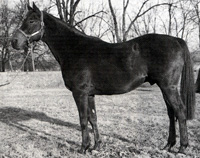 Menow  Alcibiades |
Menow br c 1935 (Pharamond -
Alcibiades, by Supremus). Family 8-g. Bred in the Beaumont Stud by Hal Price Headley, Menow was a full brother to the Demoiselle Stakes winner Lithe (b f 1946 Pharamond) and half brother to Alabama Stakes winner Salaminia (ch f 1937 Man O'War). Their dam was Debutante Stakes and Kentucky Oaks winner Alcibiades (ch f 1927 Supremus), also bred by Mr Headley. She was later the 4° dam of 2000 Guineas and Derby winner, Sir Ivor (b c 1965 Sir Gaylord). |
|||||||||||||||||||||||||||||||||||||||||
|
|
||||||||||||||||||||||||||||||||||||||||||
|
||||||||||||||||||||||||||||||||||||||||||
|
|
||||||||||||||||||||||||||||||||||||||||||
| Menow ran for 2 years, winning 7 of
17, and earning
$140,100. At 2 he won the Champagne Stakes at Belmont Park, beating Bull Lea (br c 1935 Bull Dog) and the Futurity Stakes, also at Belmont Park, beating Tiger (br c 1935 Bull Dog). In this latter race he set a world record for 6.5f in 1 minute and 15.2 seconds. He was the Champion Two Year Old Colt of 1937. At 3 he won the Withers Stakes at Belmont Park, beating Travers winner Thanksgiving (b c 1935 Bud Lerner) and the Massachussetts Handicap at Suffolk Downs by 8 lengths. His win over War Admiral (b c 1934 Man O'War) in the muddy 1938 Mass Cap was considered a stunning upset, but War Admiral hated heavy going and carried 130 pounds to Menow's 107 pounds. He finished 4° for the Kentucky Derby won by Lawrin (br c 1935 Insco), and 3° for the Preakness to Dauber (ch c 1935 Pennant). In his final race he broke down in both forelegs and went home to Beaumont Farm, where he covered alongside his sire, Pharamond. |
||||||||||||||||||||||||||||||||||||||||||
|
|
||||||||||||||||||||||||||||||||||||||||||
|
||||||||||||||||||||||||||||||||||||||||||
|
|
||||||||||||||||||||||||||||||||||||||||||
| In the stud he got the champion filly
of 1942 Askmenow (br f 1940). She finished 2° in the Futurity at Belmont
behind Occupation (br c 1940 Bull Dog) but beat future triple crown
winner Count Fleet (br c 1940 Reigh Count). In her final two year old
race she won the Selima Stakes beating Matron Stakes winner Good Morning
(br f 1940 Sir Gallahad). |
||||||||||||||||||||||||||||||||||||||||||
|
||||||||||||||||||||||||||||||||||||||||||
| He sired 1949 Horse Of The Year Capot
(br c 1946) who also annexed champion three year old colt honours,
winning the Preakness Stakes, beating Palestinian (ch c 1946 Sun Again),
and the Belmont Stakes, beating the Kentucky Derby winner Ponder (bbr c
1946 Pensive). Later in the autumn he won the Jerome Handicap beating
Travers winner Arise (br c 1946 He Did), then beat Coaltown (b c 1945
Bull Lea) twice, first in the Sysonby Mile, then in the Pimlico Special.
Unfortunately, in the stud Capot was nearly infertile. Menow sired 291 foals, of whom 32 were stakes winners. Without doubt his best son was 1953 Horse Of The Year Tom Fool (b c 1949), see below. Menow died at Mill Ridge Farm, Lexington, owned by Mr Headley's daughter Alice Headley Chandler, in April of 1964. |
||||||||||||||||||||||||||||||||||||||||||
| Tom Fool (USA) | ||||||||||||||||||||||||||||||||||||||||||
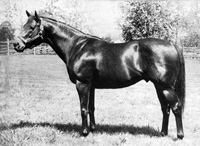 Tom Fool  Duval Adams Headley (1909-1987) was president of Keeneland Race Course from 1956 to 1970. He bred a number of highly respected racehorses, including Champion Three Year Old Filly Dark Mirage (bbr f 1965 Persian Road). |
Tom Fool b c 1949 (Menow - Gaga, by
Bull Dog). Family 3-j. Bred in Kentucky by Duval A Headley at Manchester Farm near Lexington, Tom Fool was foaled March 31, 1949. He was sold for $20,000 as a yearling to John Hay Whitney and his sister, Mrs Charles Shipman Payson, who race under Greentree Stable colours. His dam, Gaga (b f 1942) won 7 of her 26 starts earning $15,875 and also foaled the Demoiselle Stakes winner Aunt Jinny (ch f 1948 Heliopolis). His 3° dam, Laughing Queen (b f 1929), was a full sister to a top class racehorse and stallion, Pompey (b c 1923 Sun Briar). |
|||||||||||||||||||||||||||||||||||||||||
|
|
||||||||||||||||||||||||||||||||||||||||||
|
||||||||||||||||||||||||||||||||||||||||||
|
|
||||||||||||||||||||||||||||||||||||||||||
| He was trained by John Gaver and
ridden in all his starts by Ted Atkinson. Never worse than second in seven starts as a juvenile, he won the the Futurity, Sanford, East View and Grand Union Hotel Stakes on his way to the 1951 division title. After that impressive season, he was expected to be a Classic contender, but things did not go as planned. He made his return with an allowance win at Jamaica, but then finished second in the Wood Memorial, and came out of that race with a cough that sidelined him until late June. He finished the season with six wins from thirteen starts, including two against older horses. It was as a four year old that he showed his true talents, winning all ten of his starts. Neither distance nor weight proved to be an issue - he won at distances from 5 1/2 to 10 furlongs, carrying up to 136 pounds. His wins included what was then called the "New York Handicap Triple" - the Metropolitan, Suburban and Brooklyn Handicaps - as well as the Carter Handicap, in which he carried a stakes record 135 pounds. By August, the rest of the division has seen enough of him; his last four starts, including the Whitney Handicap and Pimlico Special, were non-wagering contests in which he only faced one or two over-matched opponents. He was named Horse of the Year, Champion Sprinter, and Champion Handicap Horse for 1953. |
||||||||||||||||||||||||||||||||||||||||||
|
|
||||||||||||||||||||||||||||||||||||||||||
|
||||||||||||||||||||||||||||||||||||||||||
|
|
||||||||||||||||||||||||||||||||||||||||||
| He entered stud in 1954 at Greentree
Farm in Kentucky, where he stood his entire career despite being
syndicated in 1958. He sired 157 winners, 36 of them stakes winners,
from 280 named foals. His get included dual Classic winner Tim Tam (bbr
c 1955) and the three-time champion Buckpasser (b c 1963), who went on
to be an excellent sire and influential broodmare sire. |
||||||||||||||||||||||||||||||||||||||||||
|
||||||||||||||||||||||||||||||||||||||||||
| Silly Season (br c 1962) was a high
class runner in England, winning the Dewhurst Stakes as a two year old
and the Champion Stakes and St. James's Palace Stakes as a three year
old. He was runner up to Niksar (ch c 1962 Le Haar) for the 2000 Guineas
Stakes. Tom Fool himself also did well as a broodmare sire, his daughters producing 89 stakes winners and five champions. Tom Fool was pensioned in 1972 and died August 20, 1976. |
||||||||||||||||||||||||||||||||||||||||||
|
|
||||||||||||||||||||||||||||||||||||||||||